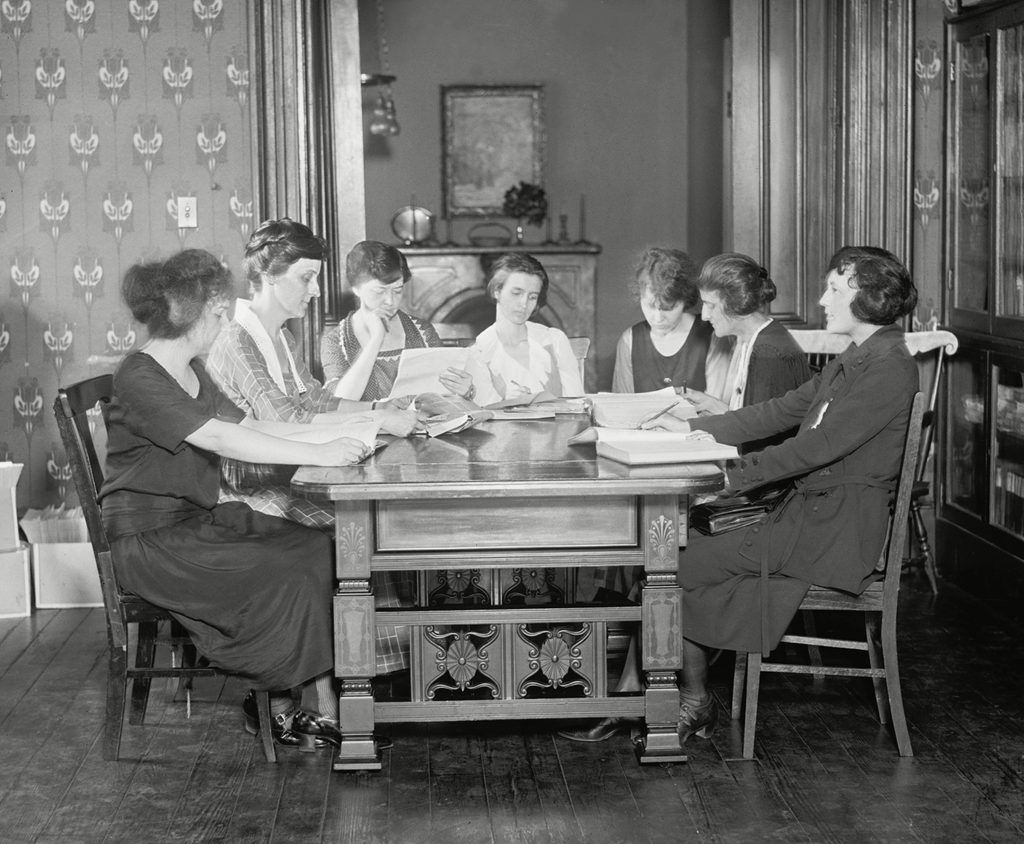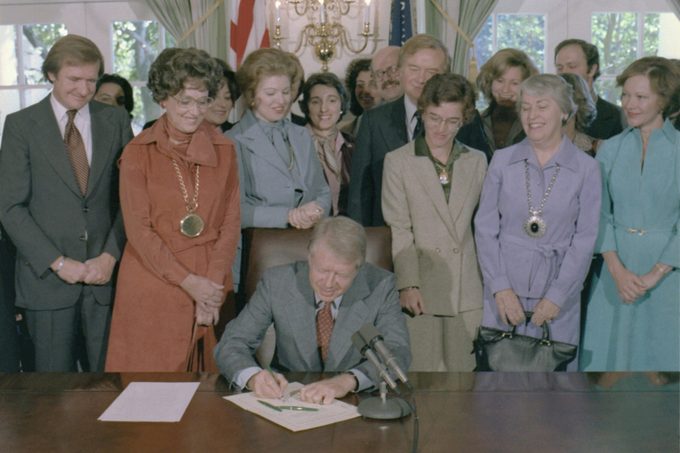16 Facts and Figures About the Equal Rights Amendment
Updated: Jan. 17, 2024

Equality for the genders is not, in fact, a given or the land of the law as currently stipulated by the U.S. Constitution.
The Equal Rights Amendment (ERA) already exists…right?
You may think that, surely, gender equality across the board in America not only at the voting booth is already a ratified amendment of the U.S. Constitution. You would be wrong, but you would not be alone.
According to the New Republic, “most Americans believe the ERA already exists, that it’s ancient history. But if anything, the resurgence of the #MeToo movement, by spotlighting the continued second-class treatment of women in our society, shows us that the ERA is more important than ever.”
So what is the Equal Rights Amendment?
As defined by the non-profit website of the Alice Paul Institute (API), “The Equal Right Amendment is a proposed amendment to the United States Constitution designed to guarantee equal legal rights for all American citizens regardless of sex; it seeks to end the legal distinctions between men and women in terms of divorce, property, employment, and other matters.”
How long has the fight for equal rights been going on?
This particular fight is almost a century in the making—and counting, unfortunately.
The idea of equality among genders was actually first proposed by the National Woman’s political party and suffragist Alice Paul nearly a century ago, in 1923. More than four decades later, however, in the late 1960s, the revival of feminism ushered in its introduction into Congress on the heels of the passage of the Equal Pay Act, one of the pivotal moments that changed women’s history forever.
Three of the most important women in Equal Rights Amendment history
Lead by the U.S. Representative from New York, Bella Abzug, and two famous fighters for equality, Gloria Steinem and Betty Friedan, the amendment received the requisite two-thirds vote from the House in October of 1971 and from the Senate in March of the following year, says History.com, thus paving the way for what should have been the 27th Amendment.
Ratification by the states

Okay, it was passed by the House of Representatives and the Senate, so we were all set then, right? Close, but not quite. Three-fourths of the 50 states (that amounts to 38 of them) need to also ratify the amendment, through each state legislature, to make it official.
The first state to ratify the Equal Rights Amendment was…
The last state admitted to the union, Hawaii, was the first to ratify the Equal Rights Amendment. After Hawaii, 30 other states followed suit within a year but sadly that wasn’t enough to officially ratify the ERA as the 27th Amendment to the U.S. Constitution.
Why did other states not ratify the amendment?
Thirty-eight states were needed to ratify the ERA but in the mid-70s, Phyllis Schlafly spearheaded one of the first conservative grassroots movements in the U.S, according to the BBC, and the resulting conservative, anti-equality backlash railroaded ratification, stalling progress in America.
Therefore, with the notable exception of the right to vote for all sexes, gender legal equality in the U.S. was never, and still is not, formally protected by the U.S. Constitution.
Did most Americans approve of gender equality in the 1970s?

Overwhelmingly, yes. Per the BBC, “According to Gallup Polls from 1975 to 1981, the majority of Americans—men and women—were in favor of the amendment. In the 1970s, only an average of 27 percent of those polled opposed it.”
How close to ratification the Equal Rights Amendment get?
By 1977, 35 states had ratified the ERA—and then the movement stalled…until recently.
Why are we talking about Equal Rights today
During the Women’s Marches spurred by the inauguration of President Donald J. Trump, in January of 2017, there were a cavalcade of handmade signs with variations of, “I can’t believe we’re still fighting for this sh*t“. And it’s true; equal legal rights for all American citizens regardless of sex is, even still in the second half of 2019, not guaranteed by the U.S. Constitution. Take for example the four-time World Cup-winning U.S. Women’s National Soccer Team: earlier this year, they filed a class-action gender discrimination lawsuit against the U.S. Soccer Federation and chants of “Equal Pay” were routinely heard during the games. Next, learn how and why the ERA coalition is fighting for women’s equal rights.
A modern-day hero of the Equal Rights Amendment
Representative Carolyn Maloney of New York has, according to a New Republic article from June 2018, “re-introduced the Equal Rights Amendment 11 times since she was first elected in 1992. In that time, there has not been one formal congressional hearing on the amendment.” Discover 30 more pioneering women who changed the world.
#MeToo
The renewed focus on passing the Equal Rights Amendment can be, at least partially, credited to the #MeToo movement. Not only are sleazy men in power positions in Hollywood and the business world being rooted out, but per The Economist, “The energy generated has revived the old crusade: the push to ratify the Equal Rights Amendment.”
Doesn’t the 14th Amendment guarantee equal rights?
The 14th Amendment only goes so far. “During the 1970s and ’80s, Ruth Bader Ginsburg helped to persuade the Supreme Court to extend the equal protection clause of the 14th Amendment to prohibit unequal treatment on the basis of sex—similar to what the E.R.A. would have done. But supporters said that clause doesn’t go far enough, particularly when it comes to violence against women, sexual harassment and equal pay,” according to The New York Times. This is why the Equal Rights Amendment still matter today. The article goes on to add that it “has symbolic value,” and Justice Ginsburg said eloquently in 2017, “I would like to be able to take out my pocket Constitution and say that the equal citizenship stature of men and women is a fundamental tenet of our society like free speech.” Here are 20 more inspiring quotes from incredible women.
What is standing in the way now?
The ERA is now only one state away from reaching that magical 38 state figure. According to The Washington Post, in the mid-2018, “Illinois became the 37th state to approve the pending Equal Rights Amendment (ERA), putting it one state short of ratification. The amendment forbids denying equal rights on the basis of sex, could broadly reshape U.S. politics by expanding and cementing women’s rights to education, welfare, and a fair workplace, and could even protect transgender rights.” The states that haven’t ratified the ERA include: Alabama, Arkansas, Arizona, Florida, Georgia, Louisianna, Mississippi, Missouri, North Carolina, Oklahoma, South Carolina, Utah, and Virginia.
But…
Five states want to rescind their original ratification of the Equal Rights Amendment
Per EqualRightsAmendment.org, “Five states—Nebraska, Tennessee Idaho, Kentucky, and South Dakota—have attempted to rescind their initial ratification of the Equal Rights Amendment. The legality of these recissions is questionable.”
The Equal Rights Amendment will hopefully be ratified someday but the ERA won’t be the 27th Amendment
That number has since been taken by the most recent U.S. Constitutional Amendment, one that took even longer to ratify than the current fight for the ERA. According to Laws.com, “The 27th Amendment to the United States Constitution is by far the longest any Constitutional Amendment has taken to be ratified by the states. Its initial proposal began in 1789, and it took over two hundred years to complete the ratification process, finally ending in 1992.” It details how and when Congress can give itself a pay raise or pay cut. Not convinced we still need the ERA in 2019? Learning about the 16 ways women still aren’t equal to men may change your mind.
